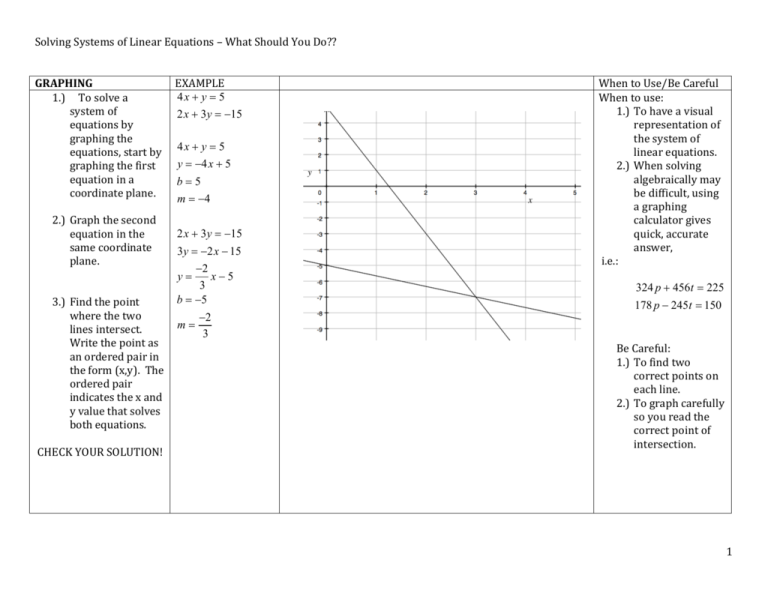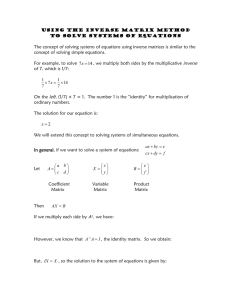Solving Systems of Linear Equations – What
advertisement

Solving Systems of Linear Equations – What Should You Do?? GRAPHING 1.) To solve a system of equations by graphing the equations, start by graphing the first equation in a coordinate plane. 2.) Graph the second equation in the same coordinate plane. 3.) Find the point where the two lines intersect. Write the point as an ordered pair in the form (x,y). The ordered pair indicates the x and y value that solves both equations. CHECK YOUR SOLUTION! EXAMPLE 4x y 5 2x 3y 15 4x y 5 y 4 x 5 b5 m 4 2x 3y 15 3y 2x 15 2 y x5 3 b 5 2 m 3 When to Use/Be Careful When to use: 1.) To have a visual representation of the system of linear equations. 2.) When solving algebraically may be difficult, using a graphing calculator gives quick, accurate answer, i.e.: 324 p 456t 225 178 p 245t 150 Be Careful: 1.) To find two correct points on each line. 2.) To graph carefully so you read the correct point of intersection. 1 Solving Systems of Linear Equations – What Should You Do?? SUSTITUTION Example 4x y 5 1.) Choose one equation and solve for one 2x 3y 15 variable in terms of the other variable. 2.) In the other equation, substitute the value of the variable you solved for. 3.) Distribute, combine like terms, and solve the equation for the one variable. 4.) Place the value of the variable you determined in step 3 into the equation you defined in step1 to solve for the other variable. 5.) Write the point as an ordered pair in the form (x,y). The ordered pair indicates the x and y value that solves both equations. CHECK YOUR SOLUTION! 1.) For this example pick Equation #1 and solve for y: 4x y 5 y 5 4x 2.) Now substitute this value of y in Equation #2: 2x 3y 15 2x 3(5 4x) 15 3.) Distribute the 3, and combine like terms, solve for x 2x 15 12x 15 10x 15 15 10x 30 x3 4.) Now find the value of y: y 5 4x y 5 4(3) y 5 12 y 7 5.) When to Use/Be Careful When to use: 1.) When an equation in your system is solved for 1 variable (i.e. y=2x) 2.) When an equation in your system has a coefficient of 1 or -1 3.) When it is easy to solve for one variable in terms of the other Be Careful: 1.) To completely solve for one variable in terms of the other (solved variable should have a coefficient of +1) 2.) Distribute correctly (3,-7) 2 Solving Systems of Linear Equations – What Should You Do?? ELIMINATION Example 1.) Evaluate the equations in 4x y 5 your system and determine if there are 2x 3y 15 terms that are opposites. 2.) 3.) 4.) 5.) If your two equations do not have opposite terms multiply one or both equations by the appropriate constant so you do have opposite terms. Use the Addition Property of Equality to add the equations together, the result will be 1 equation with 1 unknown. Solve the equation Plug-in the value for the variable solved in step 3 into EITHER original equation to find the value of the second variable. Write the point as an ordered pair in the form (x,y). The ordered pair indicates the x and y value that solves both equations. Solution 1.) There are no opposite terms, so multiply Equation 1 by (-3) to get opposite terms: 3(4x y 5) 12x 3y 15 2x 3y 15 2x 3y 15 2.) Add the equations: 10x 30 3.) Solve for x x3 4.) Solve for y 4x y 5 4(3) y 5 12 y 5 y 7 5.) (3,-7) When to Use/Be Careful When to use: 1.) If your system of equations has opposite terms 2.) If you can easily multiply one or both equations in your system to have opposite terms. 3.) If graphing and substitution are not easy methods. Be Careful: 1.) To have opposite terms before adding your equations 2.) When multiplying an equation by a constant multiply the ENTIRE equation by the constant. CHECK YOUR SOLUTION! 3 Solving Systems of Linear Equations – What Should You Do?? 4







